#poirot!ken behind the camera is <3<3
Text


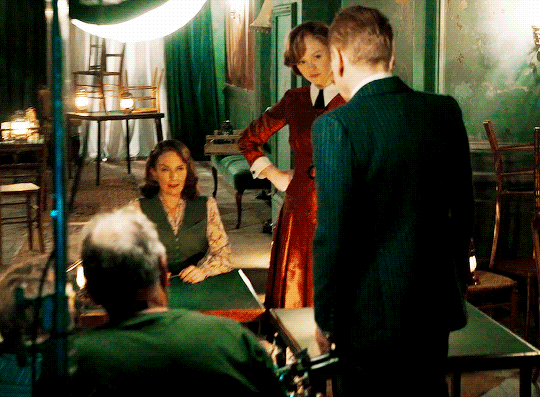


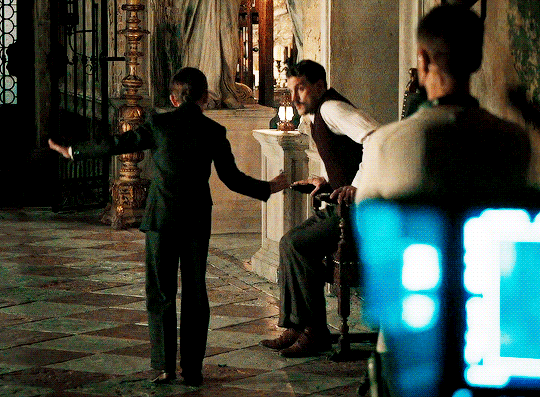
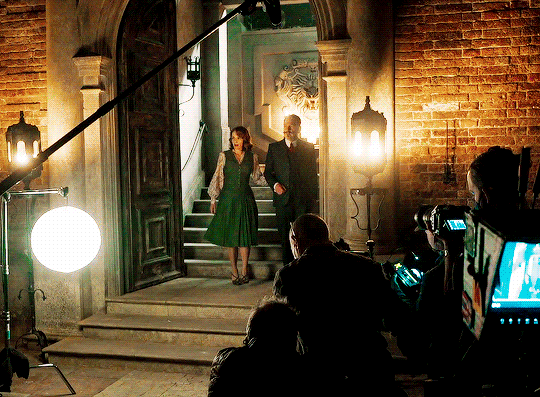


A Haunting in Venice Behind the Scenes Featurette
All of them are suspects. See the all-star cast in A Haunting in Venice, only in theaters September 15.
#a haunting in venice#poirot#hercule poirot#agatha christie#kenneth branagh#tina fey#jamie dornan#michelle yeoh#perioddramaedit#filmedit#ahauntinginveniceedit#*edit#kelly reilly#jude hill#riccardo scamarcio#camille cottin#emma laird#i'm back from vacation!#which means it's time to gif more poirot :D#poirot!ken behind the camera is <3<3#love the cast saying how collaborative ken is#jamie dornan said ken organized#all these 'team bonding exercises' <3
208 notes
·
View notes
Text

This is the 2nd part of the "Riddle of the Spinx" interview with Death on the Nile cinematographer Haris Zambarloukos for British Cinematographer November 2020 issue (part 1 transcribed here). The full interview has now been released on the British Cinematographer website. I've included some of the text below!
In Part 2 Zambarloukos talks about shooting with the cast on location in Egypt and doing a particularly complex single shot of them on set, how they did the opening b&w sequence of young Poirot as a soldier, and built sets of Abu Simbel and the pyramids, the use of realtime footage projected on LED screens to make the studio sets look more realistic, what part of the Murder on the Orient Express set they recycled for Nile, etc.
Q: This was shot like Murder on the Orient Express at Longcross Studios with plates filmed on location in Egypt. Was it ever a possibility to shoot entirely on location?
Haris Zambarloukos: The issue is that 1934 Egypt barely exists today. For example, in the 1960s they moved the Abu Simbel temple 300 metres away so that the Aswan Dam wouldn't flood it. So, we built the entire four-storey high Abu Simbel at Longcross, complete with banks of water. The same with Giza and the Sphinx. In the 1930s the Nile went up to the feet of the Sphinx. Now all you see is the concrete expanse of Cairo.
Secondly, it's difficult to shoot complex shoots on a river while floating, taking all the cast down there and scheduling them, on top of ensuring everyone's safety on such a high-profile project.
Our whole design and research went into creating a set. We wanted to build a life-size boat inside and out; not to break it down into small sets but to shoot it as if we were on a boat. That’s a huge undertaking. Jim Clay built an amazing set to scale for the Karnak. It was so big we needed to build a temporary sound stage around it. We also wanted to use some real daylight when we got great sunlight in Longcross and use a little bit of water to basically film the boats carrying guests to the Karnak.
We recycled the railway from Orient and built the boat on that so we could wheel it in from outdoors to indoors. We built a very elaborate lighting rig that you could pull back and see the entire boat in one shot. You could step onto the boat and walk through all the rooms which were all lit for an analogue film f-stop. It was complicated and took most of our planning but I personally don't think you can tell the difference when we cut - even from a shot filmed outside in real sunlight juxtaposed with one in apparent sunlight on our sound stage. It's seamless because we took such great care and a detailed approach to our rig and construction.
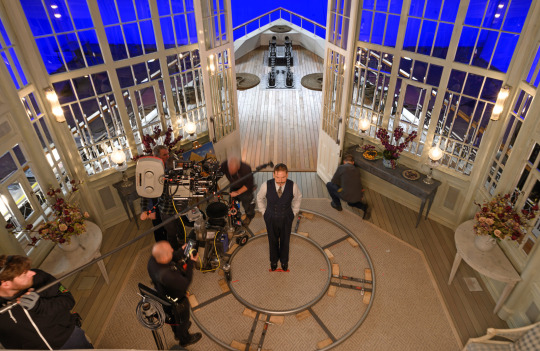
In Orient you created some stylish direct overheads of the train carriage. You've told us of the Steadicam dance sequence in Nile. Were there other stylistic flourishes?
Inside the sound stage we went twice round the Karnak with the entire cast all choreographed for this one great reveal of a murder. It was really hard work to do. I understand why it was cut in the edit although they have kept a lot of other single long takes and there are lots of places where you see the whole cast in a single shot.
However difficult you might think setting up a long single is in terms of lighting and operating, it is equally, if not more difficult, to block a scene with multiple actors, keep the audience engaged and choreograph it in a way that is exciting and at the same time reveals things gradually. There's a lot of pressure on a lot of people in shots like that. Everyone's got to be on top of their game. Because we're all so interdependent, it's a domino effect in that the further you go in the take, the bigger the responsibility is for not getting it wrong whether that's the operator, focus puller, the actor saying the final line, the gaffer lighting a corner at just the right time. We always get excited about those shots but also very nervous.
You augmented the studio work with plates photographed on location in Egypt. Tell us about that.
We filmed on the Nile from a boat with a 14 8K Red camera array. We had a 360-degree bubble on top of the boat and two three-camera arrays pointing forwards and backwards as we travelled up and down. We specifically chose areas where modernity wasn’t present (or where it was, we removed it in post) and we also shot plates from the point of view of passengers onboard the Karnak.
VFX supervisor George Murphy edited the footage and stitched the plates together into an essentially very, very advanced virtual reality rig in which I could pan my camera. We did that before principal photography, so we never had to guess a month or so later what to put there. That’s a big help. Most shoots do their plate photography afterwards. It meant I could pretty much place the camera on any deck of the Karnak for any scene and know what the background would be.
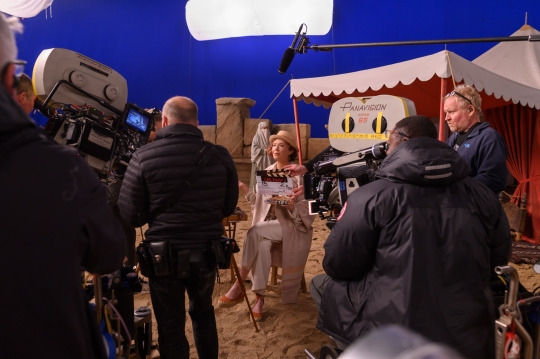
As with Orient, did you play back footage realtime on LED screens outside the boat set?
I'd love to have done it live but on Orient we were only dealing with one wagon's windows at a time. It was still the biggest LED set-up ever done to that point, but the Karnak set is 20 time bigger than that. There aren't enough LED screens available – plus it would have been prohibitively expensive.
Instead, I went for a much larger version of a technique I'd used on Mamma Mia which was to hang back projection screens all around the boat – 200m in circumference, 15m high. We used Arri SkyPanels at a distance to create a sky or a part of the background. It could also be converted into a blue screen when we needed to. It meant that if I had a shot looking above the horizon line into the sky then it could be done in camera.
How confident were you of retaining colour and contrast from set to post?
I took stills on the recce and we used those to the create colours with this back projection for our skies. I take prints (not digital stills) so there is no misinterpretation. A still is a piece of paper that you can see. Once something is emailed across and seen by someone watching on another screen the information can get lost.
At the same time there were a lot more checks and balances put in place. We had a projector at Longcross and I watched dailies with (dailies colourist) Sam Spurgeon every lunchtime. With Kodak and Digital Orchard we have a very quick process to convert analogue filmmaking into digital by the next morning. Film is processed at night, they scan at 4am and by mid-morning those digital images are transferred to our dailies suite at Longcross. At lunch we’d watch it digitally projected, having been processed, scanned and graded at 2K.
I check that first and give notes to Sam and those get transferred onto our dailies which is what Ken, the editorial team, VFX and studio team sees. That's a major check. It's me with someone in a room, rather than me talking over the phone which is a big difference. I have a very good relationship with Goldcrest and (DI colourist) Rob Pizzey who also sees things along the way. I supervise the grade at the end. So, there's no need for anyone to interpret anything. It’s a collaboration in which we all look at the same images.
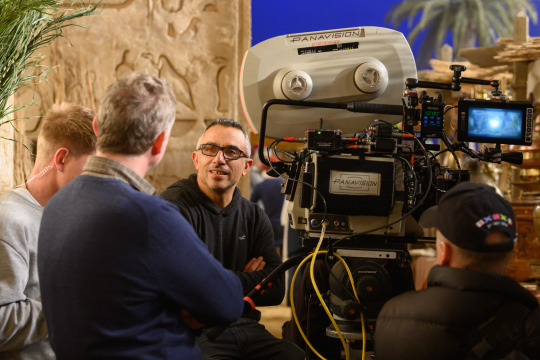
Did you shoot black and white for the opening scene or convert?
We shot colour for a couple of reasons. Although Kodak could manufacture BW 65, there is no lab in the world to processes it. Plus, there’s a certain skill to grading BW using colour negative and the added benefits are that that you can place a grey tone to a colour. For example, you could take red and decide it will look a very dark grey or a light grey, so you get very detailed tones. Ultimately, I get much more control in the DI this way. They were very monochromatic battlefield sets and costumes so it was quite limited in this case. The Germans wore grey and the Belgians wore dark blue and it’s a dark sooty gas-filled battlefield but you could manipulate the blue in the sky a little bit more and certainly manipulate the intensity of people’s eyes - especially if they had blue eyes (which Branagh does).
How did you handle sound sync?
To do sound sync work on Orient we used sound cameras that are twice as heavy as high-speed cameras, so I wanted to develop soundproof housing (blimp) for our camera on Nile. I took the problem to Stuart Heath at BGI Supplies at Longcross. They've made all sorts of props for us before, from Cinderella’s carriage to the furniture on Nile. I told him that I needed it really quickly. All my other attempts had failed. Stuart suggested using a material that they soundproof the interior of helicopters with. He brought a draper in who basically measured the camera as if making a dinner suit for it and quickly made a couple of versions for us. It was very effective and really opened up the Steadicam possibility for us. All from just wandering onto a workshop on the lot and asking a friend if he had any ideas about how to achieve something. In the old days that’s what everyone did – the answer was somewhere on the lot.
Finally, after six films and 14 years working with Ken Branagh, could you tell us what makes your relationship tick?
It is a fantastic friendship. To begin with you must be able to maintain a professional friendship with any cast and crew which is all about doing your very best and understanding where you have common aesthetics and shared thoughts about humanity. Ask what kind of world you want this to be, because that will come through in your filmmaking.
As you say, I've spent years working in close proximity to Ken and we have a mutual affection and admiration for each other otherwise we wouldn't be doing it for so long. He is relentless in pursuit of perfection and in his advancement of storytelling and is inspiring to work with. It means you have to be as relentless in your area of craft.
I think we both like making the same kinds of films. I'm a Greek Cypriot who grew up with Greek myth and tragedy. Ken's love of Shakespeare is legendary. You can easily see the lineage between Aeschylus (the ancient Greek creator of tragedy) that goes all the way to Shakespeare. Perhaps that appreciation for the human condition in its best and worst forms is the tie that binds.
Photo credit: Rob Youngson
Source: britishcinematographer.co.uk - February 4 2021
#death on the nile#agatha christie#poirot#hercule poirot#kenneth branagh#been waiting for them to release the rest of the interview! \o/#it goes into a lot more detail than the average article#great interview for fans of behind the scenes stuff#ken's brilliance strikes again :)#i'm fascinated by the 'going twice around the karnak' single shot#sounds like the 'figure 8' shot in MOTOE but even more complex#and they fragmented it?#and the LED screen tech is much larger this time#OMG poirot in dark blue belgian army uniform <3#hope they release some promo pics of it so we can see it in color#the overhead pic of poirot on set has circular camera tracks around him#it's gonna be an awesome shot i'm sure
48 notes
·
View notes
Photo

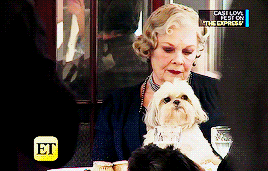



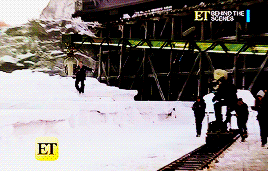


Murder on the Orient Express - Behind the Scenes
#murder on the orient express#poirot#hercule poirot#kenneth branagh#daisy ridley#judi dench#michelle pfeiffer#orientexpressedit#*edit#don't you just love behind the scenes stuff?#i could watch 3 hours of this#i wish i was there#hope we get more on the dvd#ken as poirot behind the camera is one of my fave shots#and poirot in a parka#daisy looking cute and having her hair fixed :))#flowers for judi and ken clapping#sweet little dog in the 2nd gif awww#badass poirot on top of the train#i'm living
113 notes
·
View notes
Note
hey there any idea where to watch all of the murder on the orient express deleted scenes? :)
Hey there, anon! Thank you for your ask. There are 11 deleted scenes on the Murder on the Orient Express (2017) dvd. Some have been uploaded online via media outlets and some by fans. I’m including links to the uploads, and my own screencaps of the rest of the scenes:
- Hotel Check-in - Poirot arrives at the Tokatlian hotel in Istanbul. He’s telegrammed specific orders about his room reservation (10 bath towels, 10 bottles of mineral water, etc). The scene introduces his OCD. I did a gif set of it.
- Poirot Bedtime Rituals - We see Poirot’s slimming exercises routine and moustache grooming. He’s wearing a corset. Here’s a gif set. The only look we have at Poirot’s famous moustache kit. Ken Branagh talks about the kit here.
- Pierre Michel (the conductor) interview - The only suspect interrogation scene they cut. It’s a shame because Marwan Kenzari’s performance is touching, and the location they went with for the interview is visually interesting.
- Departure - A great shot of the Orient Express leaving the station. We see all the characters inside the traincars as they speed past the camera. Poirot is at the very end in the last car, looking pleased. This isn’t a CGI scene, it was shot in camera.
- The following tweet from a fan has a video of three deleted scenes:
1) The Mr Ratchett/Poirot sequence from the Arasta Bazaar/Alternate Opening scene, an alternate - and much longer - intro scene of several characters before they get to board the train. The widowed Mrs Hubbard is chatting up a bunch of local children, Pilar Estravados the missionary is talking to a jewelry seller, Miss Debenham is taking pictures on her camera and spots the Count and Countess Andrenyi.
In the movie we only see Ratchett and the Count and Countess Andrenyi at the cafe, but no Poirot, who got cut out. In the full deleted scene he’s got a bigger role, he sees the Count fighting the paps and is about to intervene (rising from his chair), when the Countess arrives and the fighting stops. Poirot sits down again. He’s eating a lot of food, and getting excited over famous desert, and like the clip in the tweet shows, Mr Ratchett is also ordering him a bottle of champaigne, but Poirot asks for a cup of hot chocolate instead, and toasts Mr Ratchett in thanks. Chefs making the chocolate for Poirot and closeups of Godiva chocolate do not appear in either the deleted scene or the theatrical cut. I giffed the Godiva sequence here.

2) Dreamscape - The full “Poirot vision”-like scene in b&w in which we get inside Poirot’s mind. It’s a sort of re-cap of the different clues Poirot’s gathered so far. He’s looking at all the suspects one by one, and there’s a cool group shot of them facing him. More on this scene below.
3) bits of the Poirot Bedtime Rituals scene I’ve already mentioned.
That’s all the scenes I’ve managed to find online, there might be more out there, the studio took down several clips. The ones left from the dvd are:
- Alternate Opening - B&w scene of Colonel Armstrong alone in a gloomy, darkened living room. He’s watching a projector clip of himself, his wife and daughter at play when they were all happy and carefree. Little Daisy is playing with her teddybear and dolly.

- Newsreel (Extended) - B&w reel of news footage and newspaper clippings about the Armstrong kidnapping case, “the story that shocked the world”. It serves as background info for the audience. Shots of the crime scene, the funeral, mother screaming on the floor, Daisy’s teddybear guarding a fresh grave.
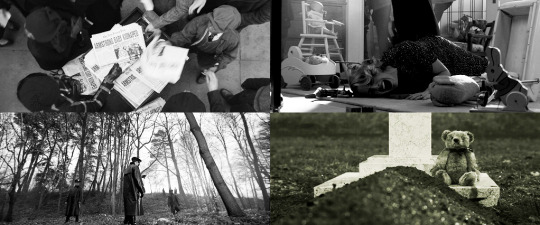
- Breakfast - The extra footage that was cut from the Wailing Wall scene. After Poirot exposes the Chief Inspector, the Inspector wants to attack him from behind but Poirot intercepts with his cane without looking back. He doesn’t see the breakfast boy with the eggs who’s followed him to the Wall, and he swings his cane, hitting theeggs by accident. The tops of the eggs the boy is holding out to him, are cut off. Next shot is of Poirot finally eating breakfast, he’s seated by the Wall, with the boy and a waiter standing beside him.

- Train Montage - A short clip of Orient Express staff/waiters setting the tables, bringing in crates of food, arranging champaigne bottles, etc. Just a few extra shots that didn’t make it into the film.

- Luggage - Bouc and Michel the conductor going through some of the passengers’ luggage. Mostly closeups of the contents of their suitcases, with quick shots of Estravados the missionary, Schmidt the maid, Marquez the salesman and Hardmanthe professor, and one extra line from Estravados.

There are about 30 mins of other deleted footage that never landed on the dvd, including two major action scenes - Poirot chasing MacQueen the assistant out in the blizzard, shooting at MacQueen in warning, then saving him from drowning when the man falls into a river, and Poirot defending himself from Dr Arbuthnot, almost falling off the train and using his wits to get back inside.
Changes from the original script to the theatrical cut: The original denouement scene happened in the dining car like in the book (and the 1974 movie), not outside, though I’m not sure if they ever filmed the first version. There are some huge differences between the original script and the film. A lot of the clue-explaining, some of the exposition, character-establishing and other character moments, extra lines from interrogation scenes, chunks of dialog, etc, were cut. Settings and certain lines of dialogue were changed. More canon quotes were added into the movie, such as Poirot’s famous “My name is Hercule Poirot and I’m probably the greatest detective in the world” line from The Mystery of the Blue Train. Miss Debeham and Dr Arbuthnot kissed twice in the original script! No kisses in the movie. Pilar Estravados was Greta Ohlsson, like in the book (Estravados’ name comes from Hercule Poirot’s Christmas). Poirot remembers his canon “love interest“ Vera Rossakoff. She only gets a mention but is kind of instrumental to him solving the case. Vera was changed into “Katherine” in the movie, a new character, someone from Poirot’s past. Was it because Vera might appear in future movies?
Most of the characters get a bit more screentime in the original script. Poirot has a HUGE, HUGE “getting-inside-the-detective’s-head” scene where he sees all the suspects frozen like ice, or like in a photograph, and he can walk through the photograph and observe each suspect, each frozen facial expression, and analyze what everyone told him in interviews. He’s looking at all the clues again in his mind, brushing away those that aren’t relevant. For the audience, this would have been a bigger and more helpful re-cap of the mystery compared to “Dreamscape” above. It would have been an amazing showstopper scene.
I wish they could have kept some of these scenes as one of the biggest criticisms about the movie was that the audience couldn’t really follow the clues and play “detective”, Poirot did all the explaining himself - and quickly - and didn’t give them enough of a chance to solve the mystery on their own. The screenwriter originally had POIROT ANALYZE ALL THE CLUES in great detail. All the clues from the book are present. Poirot’s all about the clues and observation. He brainstorms which suspect could be guilty, which pairs of suspects could have killed Ratchett together. He considers them all in his mind, all the variations and possibilities, and the audience can see his thoughts. He’s moving from one suspect to the next, in a “refresh my memory” sort of scene for the viewers.
He’s not “omnipotent” nor “guessing” like some critics have complained. He tells you how he came by the conclusions. He does it in the movie but originally he talked a lot, lot more, and the scenes were trimmed for time constraints. Some of the details regarding the clues were the first to go. I love the movie dearly and always will but there’s an even greater potential in the original script, I think. Hopefully we see more deleted footage on future dvd sets. :)
Thanks again for your ask! If anyone would like me to gif any of the deleted scenes, please let me know! :)
44 notes
·
View notes